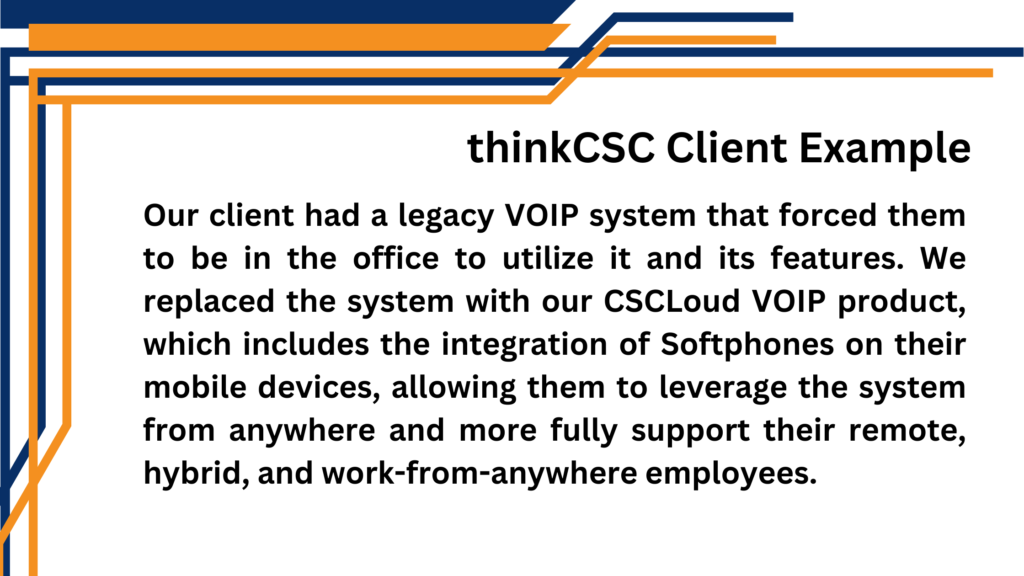
After getting a taste of working from home during the last few years, many employees – and their employers – have seen the benefit of continuing a remote workforce strategy of some kind. However, what was cobbled together under extraordinarily difficult circumstances should be revisited if your organization is making remote, hybrid, or work from anywhere a permanent option.
Today’s talent wants flexibility.
Employees now want a flexible schedule and have the ability to work at home, at the local coffee shop, or on the road while traveling with their families. And the companies who are attracting top talent are doing everything they can to offer these kinds of flexible arrangements. But to achieve success, considerable thought needs to go into the kind of security and infrastructure that is required to ensure the flexibility your workforce wants and the seamless operations your company needs. Depending on your existing infrastructure, you may be able to offer extensive flexible work arrangements and still save money by stepping away from outdated servers and moving into the cloud.
 What does it take to have a flexible workforce?
What does it take to have a flexible workforce?
Strong, comprehensive IT security is essential when you develop a remote workforce strategy. When your people are traveling and accessing your network from different locations, you need to know they’re not accidentally inviting a hacker to join them. It starts with strong Enterprise Mobility Management.
For some businesses, a work-from-anywhere strategy is necessary.
People working in Insurance, Finance, Government, Non-Profit, and Legal industries are often meeting with clients at their homes, at satellite offices, in public locations, and in their own homes. To ensure that your employees have the tools they need, smart IT investments are necessary.
 It’s more than just securing endpoints.
It’s more than just securing endpoints.
To successfully roll out a permanent remote workforce option, you have to do more than secure remote devices; you need to have a security-first philosophy and a security-first strategy. And that IT strategy needs to be flexible and agile, ready to adjust to the changing needs and demands of your business and your remote workforce.
Hardware and Software Investment Decisions for a Permanent Flexible Workforce Strategy
Supporting a remote workforce on a permanent basis, even if your merely establishing improved flexibility policies where your staff only works from home 25% of the time, means making smart investment decisions.
- Do you allow employees to use personal laptops while at home, or do you invest in a fleet of company-owned laptops that employees can use wherever they are?
- Do you have communication tools in place that make it easy for remote and on-premises teams to collaborate and communicate?
- Can your customers reach your remote employees easily through a VoIP system that extends the reach of your business phone number?
- Do you provide a VPN and other security measures, so that your remote workers can safely and securely access your network?
- Do you provide ongoing employee training to help mitigate the risk of ransomware and other cyber threats?
- Do you have strong enterprise mobility management (EMM) in place to manage device use on- and off-premises?
Remote work demands smart IT hardware and software investments that facilitate mobility, communication, and collaboration without sacrificing security.
Benefits of Offering Flexible Work Options
The smart IT investments you make to improve your remote work and work-from-anywhere opportunities pay off. Offering flexible work arrangement helps your organization attract and retain top talent. Flexible work arrangements are one of the top seven most sought after benefits.
- Increased productivity: Studies have shown that employees who work remotely or have flexible hours are more productive than those who work in traditional office settings. This is likely because they are able to work at times when they are most productive and avoid distractions.
- Reduced costs: Offering flexible work options can save businesses money on office space and other overhead costs.
- Improved employee satisfaction: Employees who have flexible work options are more likely to be satisfied with their jobs. This can lead to lower turnover and increased morale.
- Increased innovation: Flexible work options can help businesses attract and retain top talent. This can lead to increased innovation and creativity.
- Improved work-life balance: Flexible work options can help employees achieve a better work-life balance. This can lead to reduced stress and increased happiness.
At thinkCSC, we believe that in order to achieve maximum success, regardless of the size or type of your organization, you must make IT an integral part of your overall business strategy. In order to do this, partner with IT professionals who understand how to leverage technology to their advantage. We are committed to understanding your business goals and aligning your IT strategy to those goals. Furthermore, we pride ourselves on having the best business-savvy technical experts in the industry. Let’s talk.

